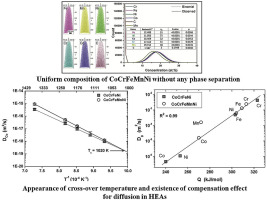当前位置:
X-MOL 学术
›
Acta Mater.
›
论文详情
Our official English website, www.x-mol.net, welcomes your
feedback! (Note: you will need to create a separate account there.)
Bulk tracer diffusion in CoCrFeNi and CoCrFeMnNi high entropy alloys
Acta Materialia ( IF 8.3 ) Pub Date : 2018-03-01 , DOI: 10.1016/j.actamat.2017.12.052 M. Vaidya , K.G. Pradeep , B.S. Murty , G. Wilde , S.V. Divinski
Acta Materialia ( IF 8.3 ) Pub Date : 2018-03-01 , DOI: 10.1016/j.actamat.2017.12.052 M. Vaidya , K.G. Pradeep , B.S. Murty , G. Wilde , S.V. Divinski

|
Abstract High entropy alloys (HEAs) have emerged as a promising class of equiatomic or near equiatomic multicomponent alloys, which garner fundamental curiosities and interest in high temperature applications. Understanding diffusion kinetics of HEAs is critical to assess their phase stability and deformation behaviour, particularly at elevated temperatures. For the first time, bulk tracer diffusion coefficients of Co, Cr, Fe and Mn are determined in polycrystalline CoCrFeNi and CoCrFeMnNi HEAs using the radiotracer method in the temperature interval of 1073–1373 K. Material homogeneity and the absence of any phase decomposition in CoCrFeNi and CoCrFeMnNi HEAs were established by electron microscopy and atom probe tomography investigations. Both bulk and grain boundary diffusion contributions to penetration profiles are observed for diffusion of Co, Cr, Fe and Mn tracers in both HEAs. The temperature dependencies of bulk diffusion for all tracers show Arrhenius behaviour. The corresponding activation energies (Q) and the logarithm of pre-exponential factors (D0) show a linear relationship, thus following the “compensation rule”. An increase of the configurational entropy leads to reduced diffusion rates only when a homologous temperature scale is used for comparison. The increase of activation energy barrier and lower frequency factors both contribute to the decreased diffusion rates. A cross-over temperature (Tc = 1020 K) is observed for Co diffusion (on slight extrapolation of Arrhenius plot) in CoCrFeNi and CoCrFeMnNi HEAs, while Cr and Fe exhibit almost parallel Arrhenius lines. Above Tc, the Co diffusivity is higher in CoCrFeMnNi than in CoCrFeNi, which suggests that diffusion in HEAs need not be assumed to retard with an increasing number of elements. The existence of a cross-over temperature correlates with the change in binding energy (or enthalpy) of the constituents from CoCrFeNi to CoCrFeMnNi.
中文翻译:

CoCrFeNi 和 CoCrFeMnNi 高熵合金中的体示踪剂扩散
摘要 高熵合金 (HEAs) 已成为一类有前途的等原子或接近等原子的多组分合金,它在高温应用中获得了基本的好奇心和兴趣。了解 HEAs 的扩散动力学对于评估其相稳定性和变形行为至关重要,尤其是在高温下。首次使用放射性示踪剂方法在 1073-1373 K 的温度区间内测定了多晶 CoCrFeNi 和 CoCrFeMnNi HEAs 中 Co、Cr、Fe 和 Mn 的体示踪剂扩散系数。 CoCrFeNi 中的材料均匀性和没有任何相分解和 CoCrFeMnNi HEA 是通过电子显微镜和原子探针断层扫描研究建立的。对于 Co、Cr、Fe 和 Mn 示踪剂在两种 HEAs 中的扩散,都观察到体块和晶界扩散对渗透剖面的贡献。所有示踪剂的体扩散的温度相关性显示出阿伦尼乌斯行为。相应的活化能(Q)与指数前因子的对数(D0)呈线性关系,因此遵循“补偿规则”。仅当使用同源温标进行比较时,配置熵的增加会导致扩散速率降低。活化能垒的增加和较低频率因素都有助于降低扩散速率。在 CoCrFeNi 和 CoCrFeMnNi HEAs 中观察到 Co 扩散的交叉温度(Tc = 1020 K)(根据 Arrhenius 图的轻微外推),而 Cr 和 Fe 表现出几乎平行的阿伦尼乌斯线。在 Tc 以上,CoCrFeMnNi 中的 Co 扩散率高于 CoCrFeNi,这表明不需要假设 HEA 中的扩散随着元素数量的增加而延迟。交叉温度的存在与从 CoCrFeNi 到 CoCrFeMnNi 的成分的结合能(或焓)的变化相关。
更新日期:2018-03-01
中文翻译:

CoCrFeNi 和 CoCrFeMnNi 高熵合金中的体示踪剂扩散
摘要 高熵合金 (HEAs) 已成为一类有前途的等原子或接近等原子的多组分合金,它在高温应用中获得了基本的好奇心和兴趣。了解 HEAs 的扩散动力学对于评估其相稳定性和变形行为至关重要,尤其是在高温下。首次使用放射性示踪剂方法在 1073-1373 K 的温度区间内测定了多晶 CoCrFeNi 和 CoCrFeMnNi HEAs 中 Co、Cr、Fe 和 Mn 的体示踪剂扩散系数。 CoCrFeNi 中的材料均匀性和没有任何相分解和 CoCrFeMnNi HEA 是通过电子显微镜和原子探针断层扫描研究建立的。对于 Co、Cr、Fe 和 Mn 示踪剂在两种 HEAs 中的扩散,都观察到体块和晶界扩散对渗透剖面的贡献。所有示踪剂的体扩散的温度相关性显示出阿伦尼乌斯行为。相应的活化能(Q)与指数前因子的对数(D0)呈线性关系,因此遵循“补偿规则”。仅当使用同源温标进行比较时,配置熵的增加会导致扩散速率降低。活化能垒的增加和较低频率因素都有助于降低扩散速率。在 CoCrFeNi 和 CoCrFeMnNi HEAs 中观察到 Co 扩散的交叉温度(Tc = 1020 K)(根据 Arrhenius 图的轻微外推),而 Cr 和 Fe 表现出几乎平行的阿伦尼乌斯线。在 Tc 以上,CoCrFeMnNi 中的 Co 扩散率高于 CoCrFeNi,这表明不需要假设 HEA 中的扩散随着元素数量的增加而延迟。交叉温度的存在与从 CoCrFeNi 到 CoCrFeMnNi 的成分的结合能(或焓)的变化相关。











































 京公网安备 11010802027423号
京公网安备 11010802027423号